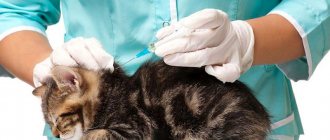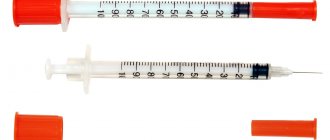How to induce vomiting in a cat is a question that often worries owners. Purr's curiosity knows no bounds. This often leads to them ingesting substances or objects that threaten their health and life. In such situations, you should act immediately - induce a gag reflex in your pet and rinse its stomach. However, sometimes such measures can make the problem worse. Before the procedure, you need to understand exactly when it will be useful and when there are serious contraindications for it.
Cases when you need to induce vomiting
Vomiting is a reflex evacuation of the contents of the stomach and duodenum through the mouth. It happens spontaneously when the stomach is full, but when an animal is poisoned, it must be provoked before the toxic components are absorbed into the walls of the digestive organ.
Inducing vomiting will be required for 2 hours until the toxic substances begin to affect the cat.
Cases when you need to empty your stomach:
- Getting into the digestive tract of poison for mice, rats, cockroaches, ants. These products contain heavy toxic substances, but sometimes they have an overly appetizing odor that attracts pets. When scattering these drugs, you need to isolate the cat for a certain time or limit access to them.
- Some owners note that their pets are attracted to the aroma of antifreeze. It is dangerous for the body because it causes kidney failure. In this case, it is advisable to induce vomiting as quickly as possible.
- Many cats persistently try to get to detergents and taste them. Washing powder, whites, pipe cleaners, soap, and dish gel pose a danger to them.
- Some weed control products contain arsenic. Gardeners leave the preparations in the public domain on their plots, and cats can taste them. Vomiting should be induced if the animal is observed eating a toxic substance.
- An open first aid kit with medications is also quite attractive to your pet, especially if it smells, for example, of valerian. Poisoning with certain types of painkillers, aspirin, and paracetamol is considered dangerous.
FAQ
What to do if a person is on a drinking binge?
If your loved one is a binge drinker, you should immediately seek drug treatment help. Persuasion to go together to a drug treatment clinic often causes a reaction of protest. In order to cut a person off from alcohol for a long time, one must create motivation for recovery.
Upon arrival at home, the narcologist provides medical measures and resorts to psychological assistance. During the intervention, a social worker or psychologist at the Narcologist-24 clinic creates motivation for getting rid of alcoholism, which becomes a reliable basis for recovery.
How to stop a woman from drinking?
In order to get a woman out of her binge, you should call a narcologist to your home. A narcologist performs professional detoxification using saline solutions and medications.
In difficult situations, it is recommended to resort to hospitalization.
Inpatient therapy has the following advantages:
- Social isolation preventing alcohol relapse;
- Guaranteed anonymity;
- 24-hour supervision by experienced medical staff;
- Possibility of using hardware techniques (UBI, plasmapheresis, etc.).
Is it possible to drink after delirium tremens?
After delirium tremens and other acute psychotic reactions, alcohol consumption is strictly prohibited. Failure can lead to irreversible consequences such as heart attack, stroke or death.
How to stop drinking beer?
Quick withdrawal from beer drinking involves detoxification using infusion solutions. In addition, as a result of beer alcoholism, diseases of the gastrointestinal tract develop, which require timely diagnosis and therapy.
How to get your husband out of binge drinking?
A man can only be brought out of a drinking binge with the participation of an emergency drug treatment team. Some relatives of alcohol addicts mix dietary supplements into food, hoping that this will help develop an aversion to alcohol.
In fact, the use of dietary supplements does not help get rid of addiction. Contact narcologists to develop an individual treatment plan for alcoholism.
How to get out of a long drinking binge?
Binge drinking can have varying durations, from two days to several weeks. Prolonged binge drinking leads to rapid destruction of organs and systems, as well as brain functions. Over time, memory loss, difficulty concentrating and thinking processes occur. Coming out of a long-term binge has several nuances:
- Need for hospitalization
. As a result of the formation of mental dependence and being in an unfavorable environment, there is a risk of breakdown. This means that the patient should be isolated from the environment for a while;
- Comprehensive detoxification
. Pharmacotherapy, hardware detoxification methods and infusion solutions are used to cleanse the body of ethyl alcohol metabolites;
- Intensive psychotherapy
. People in the later stages of alcohol addiction often lose criticality of their condition. A qualified psychotherapist helps you recognize the problem and get on the path to recovery;
- The need for an integrated approach
. Alcoholism is a disease that affects not only the physical and mental health of a person, but also the spiritual and social spheres. In a rehabilitation center, addicts find new interests and life aspirations that make integration into a sober life easier.
How to reduce alcohol consumption when binge drinking?
A gradual reduction in the dosage of alcoholic beverages does not always lead to the desired result. In some cases, a low concentration of ethyl alcohol in the body causes alcohol withdrawal: the desire to drink alcohol rapidly increases. Such consequences can only be prevented through detoxification in a drug treatment clinic.
When is it prohibited to induce vomiting?
Before inducing vomiting, you need to make sure that the cat is poisoned.
The following symptoms are typical for poisoning:
- lethargy, apathy;
- plaintive meow;
- salivation;
- nausea, vomiting;
- loose stool.
In severe poisoning, convulsions are observed.
Veterinarians do not recommend giving your cat solutions that cause vomiting if your pet has already started vomiting. This will lead to poor health.
The procedure is prohibited in the following cases:
- The animal has severe convulsions.
- Acids or alkalis have got inside, which, when moving back, can lead to additional burns of the mucous membranes.
- Piercing, sharp foreign substances have entered the esophagus or stomach; when moving back, they can cause additional injuries.
- Loss of consciousness, difficulty breathing, no swallowing movements.
- Pregnancy.
In addition, there is no point in carrying out the procedure if more than 1 hour has passed since the poisoning, and also if it occurred by inhalation or contact.
How to make a cat vomit at home
If the owner has identified symptoms of poisoning in an animal, he is interested in how to induce vomiting in a cat correctly. There are few options for the most successful procedure. It is difficult to predict in advance which method will work faster. Common ones include the use of the following substances:
- hydrogen peroxide;
- ipecac;
- warm water;
- potassium permanganate solution;
- saline solution
You can also use medications, such as Apomorphine or Xylazine. However, you should not use them at home - there is a high risk of side effects, as well as the possibility of an incorrectly calculated dose.
Note! During the New Year holidays, cats often taste the rain, attracted by its shine and rustling. In such cases, you should not induce vomiting, nor should you try to pull the Christmas tree decoration out of the mouth. The pet needs to be taken to the clinic urgently.
Hydrogen peroxide is considered an effective way to induce vomiting. To do this, you need to inject the animal with a drug (3%) dissolved in water (1 to 1) at the rate of 1 tsp per 5 kg of the cat’s weight. The procedure can be repeated after 5 minutes until the urge begins. Usually 1 time is enough.
Enhanced poisoning therapy
7,500 pcs.
- Dropper volume 1500 ml
- Visit of a narcologist
- Patient examination
- Consultation with a narcologist
- Detoxification
- Doctor's orders
- Medicines for 3 days
- Monitoring the patient's condition
Order service
Drug treatment
Pharmacotherapy is necessary to restore internal organs. They use hepatoprotectors to normalize liver function, antidepressants to improve psycho-emotional background, tranquilizers to normalize sleep patterns, antihypertensives to lower blood pressure, etc. Pharmacotherapy is selected individually, based on the individual characteristics of the patient.
Detoxification in hospital
Detoxification in a hospital setting allows you to resort to hardware detoxification methods.
- UBOD
- detoxification, which is carried out under general anesthesia. This procedure helps cleanse the body of toxins without causing discomfort.
- Plasmapheresis
- a method of purifying blood plasma while preserving the main components.
- Ionic detoxification
- removal of toxins using active ions. The procedure does not cause discomfort and takes up to 30 minutes.
In addition, in a hospital setting, the addict is under constant supervision of medical personnel, which makes it possible to provide emergency medical care.
What to do after vomiting
Artificially induced gastric emptying is the first aid for your pet, which means further treatment will be required. It is necessary to call the veterinary clinic and find out which adsorbent agent to give to the animal. Then bring it to a specialist.
Vomiting is not only an indicator of poisoning. It is often caused by a number of serious pathologies, including infectious ones.
To provide assistance, the veterinarian will need accurate information about what substances the cat or kitten was poisoned with, and the owner will also need to describe in detail the symptoms and condition of the pet.
For complete recovery, it is important to complete the treatment, following all the doctor’s recommendations. In the future, you should protect your cat from such troubles by limiting access to toxic substances.
Character of vomit
To determine the cause of vomiting in a pet and prescribe appropriate treatment, it is necessary to study the nature of the vomit.
- The mass contains large particles of undigested food. Most often, this happens if the cat grabs food too quickly and does not repeat systematically. If such vomiting recurs, you should consult a doctor; this may be a symptom of intestinal obstruction, gastritis or pancreatitis.
- Red or pink vomit mixed with white foam. A scarlet color indicates the presence of injuries in the stomach or esophagus; the presence of brown or brown strands indicates intestinal bleeding. In this case, bleeding may be caused by injury or an ulcerative process.
- Transparent. Most often refers to hungry vomiting, sometimes with white or gray foam. Appears once. If the problem recurs, it is worth examining the cat for the presence of pathologies of the digestive system.
- White foam. Such vomiting is typical for poisoning with spoiled food or other poisons. If white foam appears in the vomit, you should immediately contact a veterinarian for help.
- Yellow vomit. In this case, there is bile in the vomit, which indicates a problem with the gallbladder or liver.
- Green vomit. In this case, they turn green when the gallbladder malfunctions, resulting in concentrated bile entering the stomach. Sometimes the green color of the vomit may indicate that the animal has eaten grass.
It is by the nature of the vomit that one can determine the intensity of the disease and the need for urgent contact with specialists.










